DPR and OEHHA Open Public Comment Period on Modified Proposed Regulations to Restrict 1,3-D Use in California
SACRAMENTO – The Department of Pesticide Regulation (DPR) and the Office of Environmental Health Hazard Assessment (OEHHA) today announced next steps in the joint-and-mutual development of regulations to restrict 1,3-dichloropropene (1,3-D) use to address cancer risks for occupational bystanders.
After the initial 45-day public comment period on the proposed regulations closed in January 2025, DPR and OEHHA reviewed the comments and scientific peer reviews. Limited regulatory changes are proposed on the regulations, and they are specified in the Notice of Proposed Modifications. Public comments will be accepted on the regulatory changes and the scientific peer review as part of a 15-day comment period, open June 5 through the end of day June 20.
To review the proposed modifications to the regulations, visit DPR’s website. Comments on the changes to the proposed regulations can be submitted to DPR through the online comment portal SmartComment, or sent by email to dpr24001@cdpr.ca.gov.
The Proposed Regulatory Action Would Ensure That Restrictions on 1,3-D Use to Address Cancer Risks to Occupational Bystanders Are Implemented on January 1, 2026.
DPR and OEHHA intend to complete the proposed rulemaking in a timely manner and to implement mitigation to protect occupational bystanders by the next 1,3-D permitting season. The proposed regulations are based on scientific data and available methodology, as well as OEHHA’s recommendations to DPR to address cancer risks to occupational bystanders.
Specifically, the proposed regulations would require:
- A minimum distance between 1,3-D application sites and people, particularly farmworkers working in nearby fields (called buffer zones). This expands on the setback requirements in previous regulations requiring specific distances between 1,3-D application sites and homes and other occupied structures.
- A requirement for DPR to continue to evaluate occupational risk associated with 1,3-D use and report on an annual basis. If necessary, and in consultation with OEHHA, DPR will be required to develop additional protections based on its annual evaluation of occupational risk. The annual evaluation will include an assessment of available data, assumptions and methods to estimate 1,3-D risk and, if necessary, update assumptions and methods to inform additional actions.
Identifying Additional Methodologies to Research Potential Pathways of Exposure to 1,3-D in Agricultural Communities
Public comments and peer review identified conflicting or inconsistent assumptions regarding potential pathways for exposure to 1,3-D. For example, public commenters and peer reviewers emphasized the availability of methods to analyze combined near-field and regional ambient air concentrations and the need for research to support the current assumptions about where workers are present (for example, how much work is conducted at the edge of a field), the number of applications nearby, the length of exposure during a workday, and breathing rates for workers. These comments confirmed the need for the requirement in the currently proposed regulations that would require DPR to annually review the effectiveness of the mitigation and the assumptions used to evaluate occupational risk.
DPR and OEHHA are committed to analyzing these issues thoroughly to consider if further mitigation proves necessary. However, at this juncture, DPR and OEHHA do not propose further mitigation measures but will review further public comment to determine whether additional changes to the regulatory text are appropriate.
Following the close of the current public comment period, if the regulation is finalized without further modification, DPR and OEHHA intend to convene roundtables with interested parties this fall to further evaluate these various methodologies and assumptions.
In early 2026, DPR and OEHHA intend to host a public workshop to share feedback and information gathered from the roundtables and provide another opportunity for public input.
Information gathered at the roundtables and workshop will help inform additional regulatory actions or mitigation that may be needed to continue to ensure that people are protected.
Decreases in 1,3-D Emissions Since Regulations to Protect Residential Bystanders Went Into Effect
DPR is tracking decreases in 1,3-D use over the last five years. Additional restrictions on 1,3-D following regulations effective Jan. 1, 2024 to address cancer and acute risks to residential bystanders have shown a 29 percent decrease in emissions due to changes in fumigation methods required by the 2024 regulations. The currently proposed regulations to add protections for occupational bystanders are expected to build on these decreases.
DPR and OEHHA Remain Committed to Identifying Reasonable Alternatives to Fumigant Pesticides
As an additional action on 1,3-D aligned with DPR’s work to foster sustainable pest management, DPR commissioned an independent study conducted by the California Council of Science and Technology on currently available, viable and effective alternatives to 1,3-D and other fumigants for managing pests in California. The study was released in March 2025, and additional information can be found on DPR’s website.
ABOUT THE DEPARTMENT OF PESTICIDE REGULATION
The California Department of Pesticide Regulation’s mission is to protect human health and the environment. The department achieves this mission by fostering safer, sustainable pest management and operating a robust pesticide regulatory system. DPR’s work includes registering all pesticides sold or used in California, conducting pre- and post-registration scientific evaluations of pesticides to assess and mitigate potential harm to human health or the environment for pesticides in the air and water, and enforcing pesticide use laws and regulations in coordination with 55 County Agriculture Commissioners and their 500 field inspectors.
DPR also conducts outreach to ensure pesticide workers, farmworkers and local communities have access to pesticide safety information. More information about DPR can be found on our website.
ABOUT THE OFFICE OF ENVIRONMENTAL HEALTH HAZARD ASSESSMENT
Our mission is to protect and enhance the health of Californians and our state’s environment through scientific evaluations that inform, support and guide regulatory and other actions.
